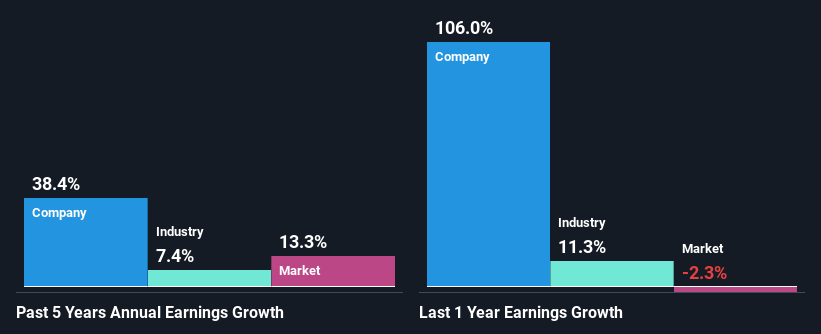Is Wabash National Corporation's (NYSE:WNC) Recent Stock Performance Tethered To Its Strong Fundamentals?
Most readers would already be aware that Wabash National's (NYSE:WNC) stock increased significantly by 13% over the past three months. Given that the market rewards strong financials in the long-term, we wonder if that is the case in this instance. Specifically, we decided to study Wabash National's ROE in this article.
Return on Equity or ROE is a test of how effectively a company is growing its value and managing investors’ money. In other words, it is a profitability ratio which measures the rate of return on the capital provided by the company's shareholders.
See our latest analysis for Wabash National
How Is ROE Calculated?
Return on equity can be calculated by using the formula:
Return on Equity = Net Profit (from continuing operations) ÷ Shareholders' Equity
So, based on the above formula, the ROE for Wabash National is:
42% = US$232m ÷ US$550m (Based on the trailing twelve months to December 2023).
The 'return' is the profit over the last twelve months. So, this means that for every $1 of its shareholder's investments, the company generates a profit of $0.42.
What Is The Relationship Between ROE And Earnings Growth?
So far, we've learned that ROE is a measure of a company's profitability. Based on how much of its profits the company chooses to reinvest or "retain", we are then able to evaluate a company's future ability to generate profits. Generally speaking, other things being equal, firms with a high return on equity and profit retention, have a higher growth rate than firms that don’t share these attributes.
Wabash National's Earnings Growth And 42% ROE
Firstly, we acknowledge that Wabash National has a significantly high ROE. Additionally, the company's ROE is higher compared to the industry average of 13% which is quite remarkable. Under the circumstances, Wabash National's considerable five year net income growth of 38% was to be expected.
We then compared Wabash National's net income growth with the industry and we're pleased to see that the company's growth figure is higher when compared with the industry which has a growth rate of 7.4% in the same 5-year period.
Earnings growth is a huge factor in stock valuation. What investors need to determine next is if the expected earnings growth, or the lack of it, is already built into the share price. This then helps them determine if the stock is placed for a bright or bleak future. What is WNC worth today? The intrinsic value infographic in our free research report helps visualize whether WNC is currently mispriced by the market.
Is Wabash National Making Efficient Use Of Its Profits?
Wabash National has a three-year median payout ratio of 34% (where it is retaining 66% of its income) which is not too low or not too high. By the looks of it, the dividend is well covered and Wabash National is reinvesting its profits efficiently as evidenced by its exceptional growth which we discussed above.
Besides, Wabash National has been paying dividends over a period of seven years. This shows that the company is committed to sharing profits with its shareholders. Upon studying the latest analysts' consensus data, we found that the company's future payout ratio is expected to drop to 12% over the next three years.
Conclusion
Overall, we are quite pleased with Wabash National's performance. Particularly, we like that the company is reinvesting heavily into its business, and at a high rate of return. Unsurprisingly, this has led to an impressive earnings growth. With that said, on studying the latest analyst forecasts, we found that while the company has seen growth in its past earnings, analysts expect its future earnings to shrink. To know more about the latest analysts predictions for the company, check out this visualization of analyst forecasts for the company.
Have feedback on this article? Concerned about the content? Get in touch with us directly. Alternatively, email editorial-team (at) simplywallst.com.
This article by Simply Wall St is general in nature. We provide commentary based on historical data and analyst forecasts only using an unbiased methodology and our articles are not intended to be financial advice. It does not constitute a recommendation to buy or sell any stock, and does not take account of your objectives, or your financial situation. We aim to bring you long-term focused analysis driven by fundamental data. Note that our analysis may not factor in the latest price-sensitive company announcements or qualitative material. Simply Wall St has no position in any stocks mentioned.

 Yahoo Finance
Yahoo Finance 
